Advances in Pure Mathematics
Vol.3 No.1(2013), Article ID:27365,4 pages DOI:10.4236/apm.2013.31013
The Brunn-Minkowski Inequalities for Centroid Body
School of Mathematics and Computer Science, Nanjing Xiaozhuang University, Nanjing, China
Email: yuanjun_math@126.com
Received August 9, 2012; revised September 22, 2012; accepted October 6, 2012
Keywords: Centroid Body; The Brunn-Minkowski Inequality
ABSTRACT
In [1], the authors established the Brunn-Minkowski inequality for centroid body. In this paper, we give an isolate form and volume difference of it, respectively. Both of these results are strength versions of the original.
1. Introduction
The setting for this paper is n-dimensional Euclidean space . Let
. Let  denote the set of convex bodies (compact, convex subsets with non-empty interiors). Let
denote the set of convex bodies (compact, convex subsets with non-empty interiors). Let 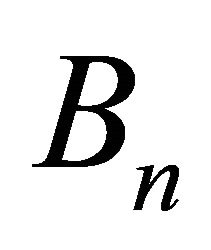 and
and  denote the unit ball and unit sphere in
denote the unit ball and unit sphere in , respectively. If
, respectively. If , then the support function of K,
, then the support function of K,  , is defined by
, is defined by
 (1.1)
(1.1)
where  denotes the standard inner product of u and x.
denotes the standard inner product of u and x.
For each compact star-shaped about the origin , denoted by
, denoted by  its n-dimensional volume. The centroid body
its n-dimensional volume. The centroid body  of K is the origin-symmetric convex body whose support function is given by (see [2])
of K is the origin-symmetric convex body whose support function is given by (see [2])
 (1.2)
(1.2)
where the integration is with respect to Lebesgue measure on .
.
Centroid body was attributed by Blaschke and Dupin (see [3,4]), it was defined and investigated by Petty [2]. More results regarding centroid body see [2-7].
For star body K and L, let 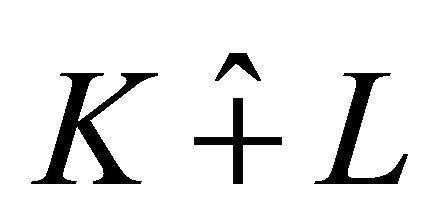 denote the harmonic Blaschke addition of K and L. In [1], the authors established the following Brunn-Minkowski inequality for centroid body.
denote the harmonic Blaschke addition of K and L. In [1], the authors established the following Brunn-Minkowski inequality for centroid body.
Theorem A. Let  be star bodies in
be star bodies in . Then
. Then
 (1.3)
(1.3)
the equality holds if and only if  and
and  are homothetic.
are homothetic.
In this paper, we give two strength versions of (1.3). Our main results are the following two theorems.
Theorem 1.1. Let  be star bodies in
be star bodies in  and
and .
.

the equality holds if and only if  and
and  are homothetic.
are homothetic.
Theorem 1.2. Let  and
and  be star bodies in
be star bodies in . Ellipsoid
. Ellipsoid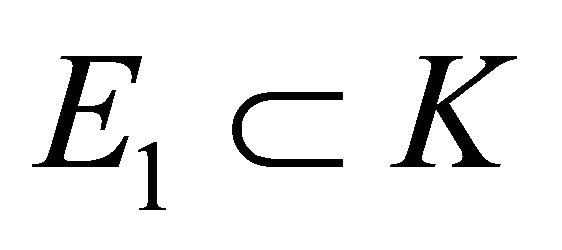 , and
, and 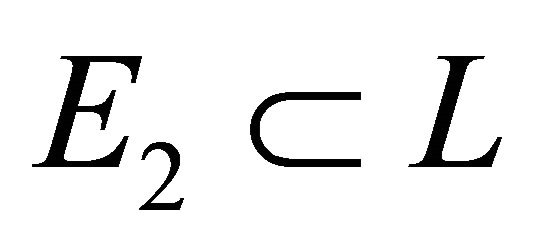 is a homothetic copy of
is a homothetic copy of . Then
. Then

the equality holds if and only if  and
and  are homothetic and
are homothetic and
 where
where  is a constant.
is a constant.
Remark. Let 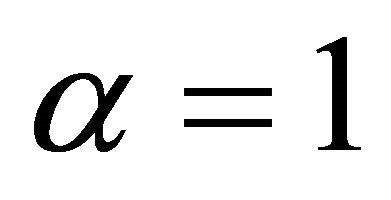 or
or 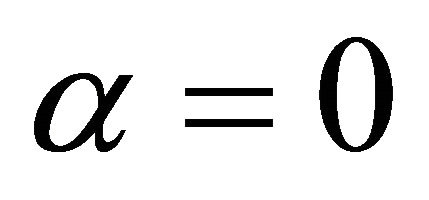 in Theorem 1.1, or let
in Theorem 1.1, or let  in Theorem 1.2, we can both get the Theorem A.
in Theorem 1.2, we can both get the Theorem A.
2. Notation and Preliminary Works
For a compact subset  of
of , with the origin in its interior, star-shaped with respect to the origin, the radial function
, with the origin in its interior, star-shaped with respect to the origin, the radial function , is defined by
, is defined by
 (2.1)
(2.1)
If 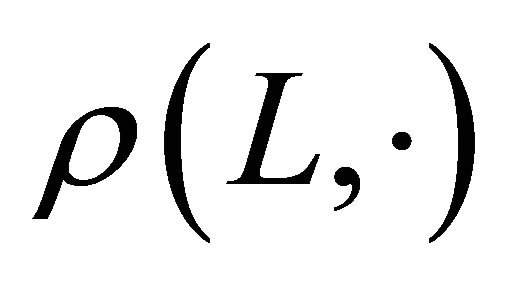 is continuous and positive, L will be called a star body. Let
is continuous and positive, L will be called a star body. Let  denote the set of star bodies in
denote the set of star bodies in .
.
The mixed volume  of the compact convex subsets
of the compact convex subsets  of
of  is defined by
is defined by

If ,
,  , then
, then
 will be denote as
will be denote as
 . If
. If , then
, then  is called the quermassintegrals of
is called the quermassintegrals of ; it will often be written as
; it will often be written as .
.
The mixed quermassintegrals
 of
of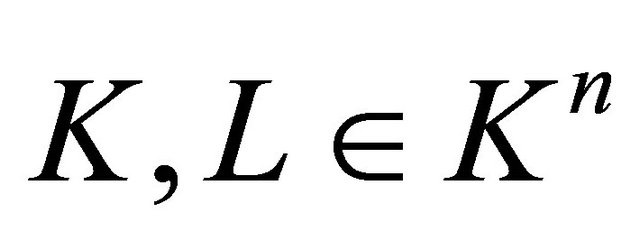 , are defined by [8]
, are defined by [8]
 (2.2)
(2.2)
Since , it follows that
, it follows that
 , for all i. Since the quermassintegrals
, for all i. Since the quermassintegrals  is Minkowski linear, it follows that
is Minkowski linear, it follows that
 for all K.
for all K.
Aleksandrov [9] and Fenchel and Jessen [10] have shown that for  and
and , there exists a regular Borel measure
, there exists a regular Borel measure  on
on , such that the mixed quermassintegrals
, such that the mixed quermassintegrals  has the following integral representation:
has the following integral representation:
 (2.3)
(2.3)
for all . The measure
. The measure  is independent of the body
is independent of the body  and is just ordinary Lebesgue measure, S on
and is just ordinary Lebesgue measure, S on . The surface area measure
. The surface area measure  will frequently be written simply as
will frequently be written simply as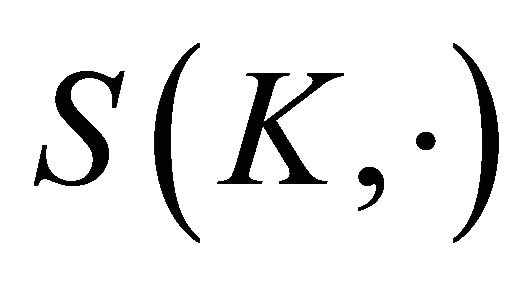 .
.
Suppose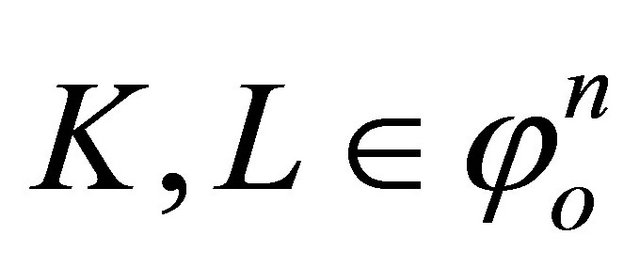 ,
, 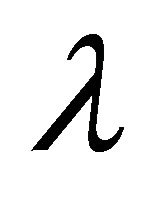 and
and  are nonnegative real numbers and not both zero. To define the harmonic Blaschke addition,
are nonnegative real numbers and not both zero. To define the harmonic Blaschke addition, 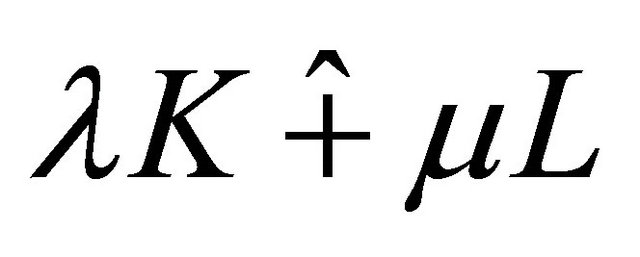 , first define
, first define  by [6]
by [6]
 (2.4)
(2.4)
The body  is defined as the body whose radial function is given by
is defined as the body whose radial function is given by
 (2.5)
(2.5)
3. Inequalities for Centroid Body
In this section, we will establish the inequality more general than Theorem 1.1 as follows.
Theorem 3.1. Let ,
,  and
and  . Then
. Then

with equality holds if and only if  and
and  are homothetic.
are homothetic.
To prove Theorem 3.1, the following preliminary results will be needed:
Lemma 3.2. ([8]). Let  and
and . Then
. Then
 (3.1)
(3.1)
with equality if and only if K and L are homothetic.
Lemma 3.3. ([11]). Let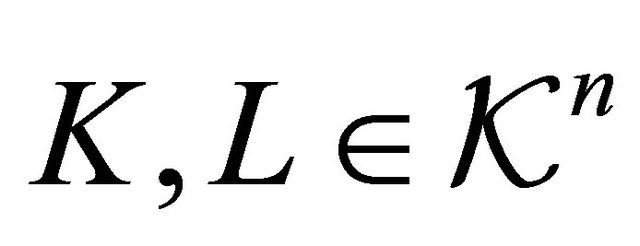 ,
, . Then
. Then
 (3.2)
(3.2)
with equality if and only if K and L are homothetic.
Proof of Theorem 3.1.
By (2.4), (2.5) and the polar coordinate formula for volume, we can get  Hence from (2.5), we obtain
Hence from (2.5), we obtain
 (3.3)
(3.3)
Using polar coordinates, (1.2) can be written as an integral over 
 (3.4)
(3.4)
Then from (3.3) and (3.4), we have
 (3.5)
(3.5)
For  and
and . Let
. Let


By (2.3) and (3.5), we have

That is
 (3.6)
(3.6)
By Lemma 3.2, we get

which implies that,
 (3.7)
(3.7)
with equality holds if and only if  and
and  are homothetic.
are homothetic.
The Brunn-Minkowski inequality (3.2) can now be used to conclude that
 (3.8)
(3.8)
with equality holds if and only if F and G are homothetic.
By (3.7) and (3.8), we get the first inequality of Theorem 3.1. By the equality conditions of (3.7) and (3.8), the first equality of Theorem 3.1 holds if and only if  and
and  are homothetic.
are homothetic.
By (3.5) and Lemma 3.3, we get
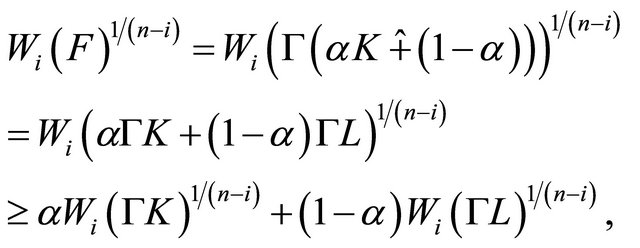
Similarly,

Hence,

with equality holds if and only if  and
and  are homothetic. This completes the proof.
are homothetic. This completes the proof.
Let  in Theorem 3.1, we obtain an isolate form of Brunn-Minkowski inequality for centroid body.
in Theorem 3.1, we obtain an isolate form of Brunn-Minkowski inequality for centroid body.
Corollary 3.4. Let  be star bodies in
be star bodies in  and
and .
.

the equality holds if and only if  and
and 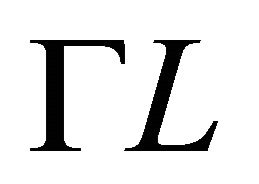 are homothetic.
are homothetic.
Now, we establish the volume difference of BrunnMinkowski inequality for centroid body.
Theorem 3.5. Let  and
and  be star bodies in
be star bodies in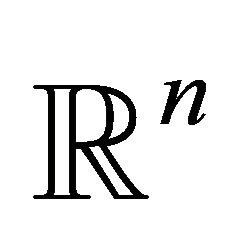 . Ellipsoid
. Ellipsoid , and
, and  is a homothetic copy of
is a homothetic copy of . Then
. Then

the equality holds if and only if  and
and 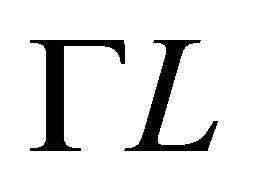 are homothetic and
are homothetic and
 where
where  is a constant.
is a constant.
To prove Theorem 3.5, we need the following two lemmas:
Lemma 3.6. (Bellman’s inequality) ([12], p. 38). Suppose that  and
and  are two n-tuples of positive real numbers, and
are two n-tuples of positive real numbers, and  such that
such that

Then
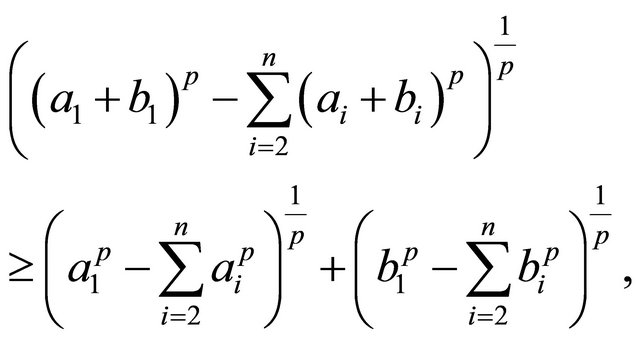
with equality if and only if , where
, where  is a constant.
is a constant.
Lemma 3.7. (Busemann-Petty centroid inequality) ([4], p. 359). Let . Then
. Then

with equality if and only if  is a centered ellipsoid.
is a centered ellipsoid.
Proof of Theorem 1.2. Applying inequality (1.3), we have
 (3.9)
(3.9)
the equality holds if and only if  and
and  are homothetic.
are homothetic.
 (3.10)
(3.10)
From (3.9) and (3.10), we obtain that
 (3.11)
(3.11)
Since 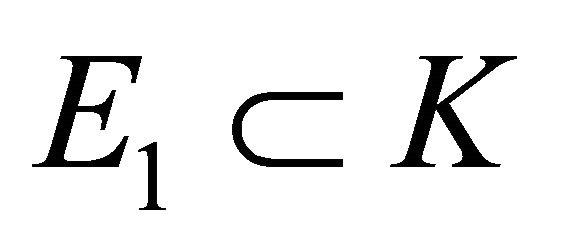 and
and  by Lemma 3.7, we get
by Lemma 3.7, we get

and

By (3.11) and Bellman’s inequality, we get
 (3.12)
(3.12)
By the equality conditions of (3.9) and the Bellman’s inequality, the equality of (3.12) holds if and only if  and
and  are homothetic and
are homothetic and
 where
where  is a constant. This completes the proof.
is a constant. This completes the proof.
4. Acknowledgements
The authors would like to acknowledge the support from the National Natural Science Foundation of China (11101216, 11161024), Qing Lan Project and the Nanjing Xiaozhuang University (2009XZRC05, 2010KYQN24).
REFERENCES
- J. Yuan, L. Z. Zhao and G. S. Leng, “Inequalities for Lp Centroid Body,” Taiwanese Journal of Mathematics, Vol. 11, No. 5, 2007, pp. 1315-1325.
- C. M. Petty, “Centroid Surface,” Pacific Journal of Mathematics, Vol. 11, No. 4, 1961, pp. 1535-1547. doi:10.2140/pjm.1961.11.1535
- K. Leichtwei, “Affine Geometry of Convex Bodies,” J. A. Barth, Heidelberg, 1998.
- R. Schneider, “Convex Bodies: The Brunn-Minkowski Theory,” Cambridge University Press, Cambridge, 1993. doi:10.1017/CBO9780511526282
- R. J. Gardner, “Geometric Tomography,” Cambridge University Press, Cambridge, 1995.
- E. Lutwak, “Centroid Bodies and Dual Mixed Volumes,” Proceedings London Mathematical Society, Vol. 60, No. 2, 1990, pp. 365-391. doi:10.1112/plms/s3-60.2.365
- G. Y. Zhang, “Centered Bodies and Dual Mixed Volumes,” Transactions of the American Mathematical Society, Vol. 345, No. 2, 1994, pp. 777-801. doi:10.1090/S0002-9947-1994-1254193-9
- E. Lutwak, “The Brunn-Minkowski-Firey Theory I: Mixed Volumes and the Minkowski Problem,” Journal of Differential Geometry, Vol. 38, 1993, pp. 131-150.
- A. D. Aleksandrov, “Zur Theorie der Gemischten Volumina von Konvexen Körpern, I. Verallgemeinerung einiger Begriffe der Theorie der Konvexen Körpern,” Matematicheskii Sbornik, Vol. 2, 1937, pp. 947-972.
- W. Fenchel and B. Jessen, “Mengenfunktionen und Konvexe Körpern,” Danske Videnskabernes Selskab. Matematisk-Fysiske Meddelelser, Vol. 16, 1938, p. 3.
- R. J. Gardner, “The Brunn-Minkowski Inequality,” Bulletin of the American Mathematical Society, Vol. 39, No. 3, 2002, pp. 355-405. doi:10.1090/S0273-0979-02-00941-2
- E. F. Beckenbach and R. Bellman, “Inequalities,” Springer, Berlin, 1961. doi:10.1007/978-3-642-64971-4

